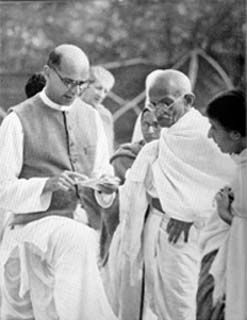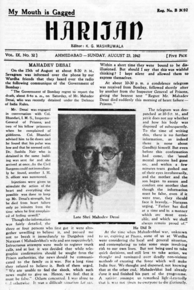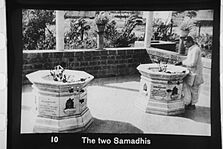Mahadev Desai facts for kids
Quick facts for kids
Mahadev Desai
|
|
|---|---|

Desai with Mahatma Gandhi
|
|
| Born | 1 January 1892 |
| Died | 15 August 1942 (aged 50) Poona, Bombay Presidency, British India (now Pune, Maharashtra, India)
|
| Nationality | British Indian |
| Education | Elphinstone College |
| Years active | 1915–1942 |
| Known for | Associate activism with Mahatma Gandhi |
| Spouse(s) |
Durgabehen
(m. 1905–1942) |
Mahadev Haribhai Desai (born January 1, 1892 – died August 15, 1942) was an important person in India's fight for freedom. He was a writer and a smart thinker. Most people remember him as the personal secretary and close friend of Mahatma Gandhi. He was like Gandhi's shadow, always by his side.
Contents
Mahadev Desai's Early Life
Mahadev Desai was born on January 1, 1892. His family lived in a village called Saras in the Surat district of Gujarat, India. His father, Haribhai Desai, was a school teacher. Mahadev's mother, Jamnabehn, passed away when he was only seven years old.
In 1905, when Mahadev was 13, he married Durgabehn. He went to school at Surat High School and then studied at Elphinstone College in Mumbai. After finishing college, he earned a law degree in 1913. He then worked as an inspector at a bank in Bombay.
Working Closely with Gandhi
Mahadev Desai met Mahatma Gandhi for the first time in 1915. He wanted Gandhi's advice on how to publish a book he had translated. In 1917, Desai joined Gandhi's special community, the Sabarmati Ashram. He and his wife, Durgabehn, went with Gandhi to Champaran that same year.
Mahadev kept a detailed diary from 1917 until the day before he died in 1942. This diary recorded his daily life with Gandhi. It gives us a great look into Gandhi's life and the independence movement. In 1919, when the British government arrested Gandhi, he named Desai as his trusted helper. Desai was arrested for the first time in 1921 and spent a year in prison.
He was Gandhi's personal secretary for 25 years. But he did much more than just secretarial work. He managed almost everything for Gandhi. He helped with office tasks, looked after guests, and even helped in the kitchen. One writer said that Mahadev saved Gandhi many years of his life by dealing with unwanted visitors. Another person wrote that Desai would wake up before Gandhi and go to sleep long after him. He lived Gandhi's day three times over: planning it, being with Gandhi during it, and then writing about it in his diary.
Fighting for India's Freedom
In 1920, a leader named Motilal Nehru asked Gandhi if Mahadev Desai could help run his newspaper, the Independent. Desai caused a stir when the British government took away the newspaper's printing press. He then created a newspaper by hand, using a special copying machine.
For his writings, Desai was sent to prison for a year in 1921. This was his first time in jail. While there, he saw how badly the jail officers treated prisoners. He wrote a report about life inside an Indian jail. This report was published in Gandhi's newspapers, Young India and Navajivan. His powerful words made the British government make some important changes to improve prisons.
Desai became the editor of Navajivan in 1924. From 1925, he started translating Gandhi's autobiography into English. He published it in parts in Young India. In 1926, he won an award for an article he wrote in Navajivan.
He also took part in the Bardoli Satyagraha, a peaceful protest, with Sardar Patel. He wrote a history of this protest in Gujarati and then translated it into English as The Story of Bardoli.
During the famous Salt Satyagraha, where Indians protested the British salt tax, Desai was arrested and put in prison again. But after an agreement called the Gandhi–Irwin Pact, he was released. He then went with Gandhi to an important meeting in London called the Second Round Table Conference. He was the only person who went with Gandhi when Gandhi met with King George V.
After the meetings failed, Gandhi started the Civil Disobedience Movement again. The British government tried to stop the movement. In 1932, Desai was arrested once more and sent to prison with Gandhi and Sardar Patel. After being released in 1933, he was arrested again and held in Belgaum Jail. During this time in prison, he wrote a book called Gita According to Gandhi, which was published after his death.
He also helped organize people's movements in some of the smaller Indian states in 1939. He was in charge of choosing people for another peaceful protest in 1940. Desai's last time in prison was after the Quit India Movement was announced on August 8, 1942. He was arrested on August 9, 1942. He stayed with Gandhi at the Aga Khan Palace until he passed away six days later. He was 50 years old.
Mahadev Desai's Writings
Mahadev Desai was a very talented writer. He was good at writing in Gujarati, Bengali, and English. He is known for his translations and his original writings in Gujarati. He wrote several biographies, which are life stories of people. These include Antyaj Sadhu Nand (1925), Sant Francis (1936), Vir Vallabhbhai (1928), and Be Khudai Khidmatgar (1936), which was about Khan Abdul Gaffar Khan and his brother.
He started translating books when he was in college. He translated an English book called On Compromise into Gujarati. He won a prize for it. Later, it was published as Satyagrahni Maryada. He also translated short stories and a novel from Bengali. He translated works by the famous poet Rabindranath Tagore into Gujarati. He even translated Jawaharlal Nehru's autobiography into Gujarati.
One of his most important translation works was translating Gandhi's autobiography, The Story of My Experiments with Truth, from Gujarati into English.
Mahadevbhaini Dayari (1948–1997) is a huge collection of Mahadev Desai's diaries, published in 22 volumes. These diaries give a very close look at Gandhi's life and are a valuable record of important events in Gandhi's journey and India's independence movement.
He also wrote regularly for Gandhi's newspapers like Young India, Navjivan, and Harijanbandhu. Desai was one of the people who helped start the All India Newspaper Editors' Conference. He also wrote for many other Indian newspapers that supported the independence movement.
He wrote several books in English, including Gandhiji in Indian Villages (1927) and The Story of Bardoli (1929). He also translated Gandhi's Anasaktiyoga into English as Gospel of Selfless Action or The Geeta According to Gandhi (1946).
After his death, he was given the Sahitya Akademi Award in 1955 for his diaries, Mahadevbhaini Dayari.
Death and Remembering Mahadev Desai

Mahadev Desai passed away from a heart attack on the morning of August 15, 1942. He was 50 years old. He was staying with Gandhi at the Aga Khan Palace at the time, as they were both in prison. When Desai stopped breathing, Gandhi called out his name, "Mahadev! Mahadev!" Later, Gandhi explained that he felt if Mahadev had opened his eyes, he would have told him to get up, and Mahadev had never disobeyed him.
Gandhi himself washed Desai's body. Mahadev was cremated, or his body was burned, on the grounds of the Palace. His samadhi, which is a memorial, is still there today.
In 1983, the Indian Department of Posts released a special stamp to honor him. His son, Narayan Desai, also became a well-known follower of Gandhi and a writer. He wrote a biography of his father called The Fire and the Rose. A college in Gujarat, the Mahadev Desai Samajseva Mahavidyalaya, is named after him.



